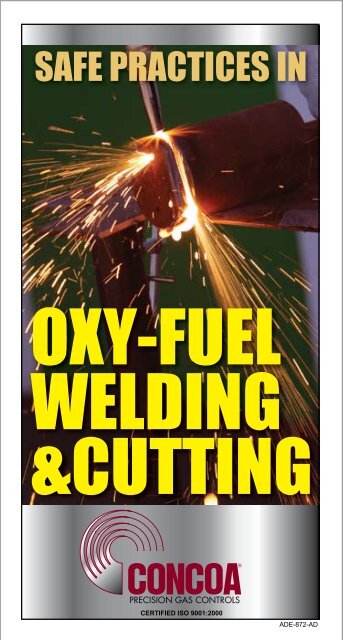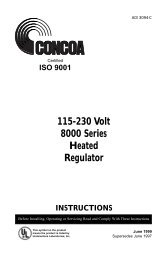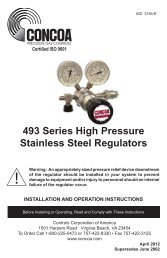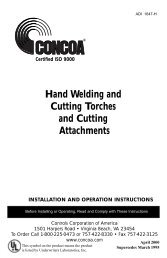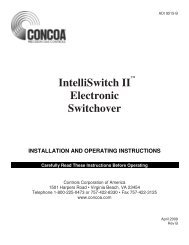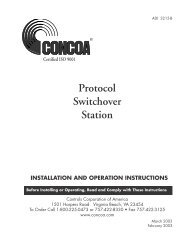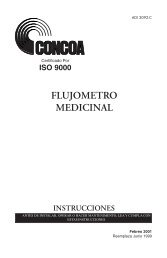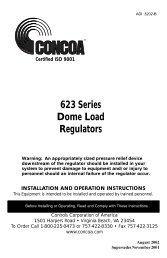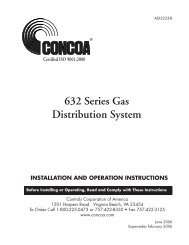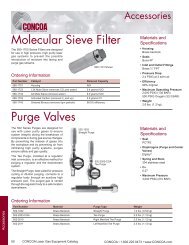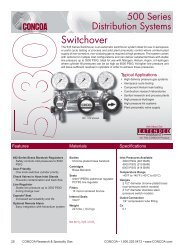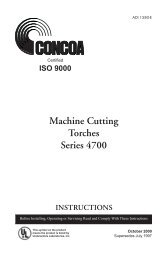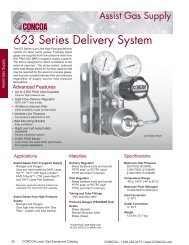You also want an ePaper? Increase the reach of your titles
YUMPU automatically turns print PDFs into web optimized ePapers that Google loves.
TABLE OF CONTENTSI. GENERAL PRECAUTIONSFOR THE PREVENTION OF:1.1 Burns 41.2 Hazardous Fume Accumulation 51.3 Fires and Explosions 6FOR THE SAFE USAGE OF:1.4 Compressed Gases andCompressed Gas Equipment 8OTHER:1.5 User Responsibilities 141.6 Leaving Equipment Unattended 14II. <strong>OXY</strong><strong>FUEL</strong> <strong>WELDING</strong> AND<strong>CUTTING</strong> SAFE PRACTICES2.1 Comply with Precautions 1.1,1.2, and 1.3 152.2 Compressed Gas System 152.3 Torch 182.4 Adjusting Pressures 192.5 Lighting Torch 192.6 Shutdown 192.7 Backfires and Flashbacks 20REFERENCE SOURCES 24
1.1.5 Medical first aid and eye treatment.First aid facilities and a qualified firstaid person should be available for eachshift unless medical facilities are closebyfor immediate treatment of flashburns of the eyes and skin burns.1.1.6 Wear ear protection when workingoverhead or in a confined space. A hardhat should be worn when others workoverhead. See OSHA for allowablenoise levels and hearing protection.1.1.7 Do not use flammable hair productswhen welding or cutting. Vapors formsuch products are usually combustibleand are easily ignited by sparks.Suitable head protection is required.1.2 Hazardous Fume Accumulation1.2.1 Adequate ventilation. Ventilateas needed to prevent harmfulaccumulations of fumes and smokethat may be produced by weldingand cutting. Consult ANSI StandardZ49-1 (listed in “Reference Sources”)for detailed ventilation requirements.N EV E R U S E OX YG E N TOVENTILATE THE WORK AREA.See ANSI Z.49.1.1.2.2 Lead-, Cadmium-, Zinc-, Mercury-,and Beryllium-bearing and similarmaterials, when welded (or cut) mayproduce harmful concentrations oftoxic fumes. Adequate local exhaustventilation must be used, or eachperson in the area as well as theoperator must wear an air-supplied
1.3 Fires and Explosions1.3.1 Causes of fire and explosion are:combustibles reached by the arc,flame, flying sparks, hot slag or heatedmaterial; misuse of compressed gasesand cylinders; and short circuits. Donot attempt to install or use equipmentbefore receiving proper training, andreading and understanding equipmentinstructions. Fire or explosion canoccur if the equipment is improperlyinstalled, repaired or used. Repairsmust be made by qualified persons.Be Aware That: flying sparks or fallingslag can pass through cracks, alongpipes, through windows or doors,and through wall or floor openings,out of sight of the goggled operator.Sparks and slag can fly 35 feet.TO PREVENT FIRES AND EXPLOSIONS:1.3.2 Keep equipment clean and operable,free of oil, grease, and (in electricalparts) of metallic particles that cancause short circuits.1.3.3 Obtain hot work permit from thesupervisor to ensure that adequateprecautions have been taken beforethe welding and cutting operationsare started.1.3.4 If combustibles are in area, do NOTweld or cut. Move the work, if practical,to an area free of combustibles. Avoidpaint spray rooms, dip tanks, storageareas, ventilators. If the work cannotbe moved, move combustibles at least
35 feet away, out of reach of sparksand heat; or protect against ignitionwith suitable snug-fitting, fire-resistantshields.1.3.5 Walls touching combustibles onopposite sides should not be weldedon (or cut). Walls, ceiling, and floornear work should be protected by heatresistantshields.1.3.6 Fire watcher must be standing by withsuitable fire extinguishing equipment,during and following welding orcutting if:a. combustibles (including buildingconstruction) are within 35 feet.b. combustibles are further than 35feet but can be ignited by sparks.c. openings (concealed or visible) infloors or walls within 35 feet mayexpose combustibles to sparks.d. combustibles adjacent to walls,ceilings, roofs, or metal partitionscan be ignited by radiant orconducted heat.1.3.7 After work is done, check that areais free of sparks, glowing embers, andflames.1.3.8 An empty container or piping thatheld combustibles, or can produceflammable vapors when heated, mustnever be welded on or cut, unless ithas first been cleaned and preparedas described in AWS Bulletin F4.1,(listed in “Reference Sources.”)This includes: a thorough steamor caustic cleaning (or a solvent or
. Regulator relief valve is designedto protect only the regulator fromoverpressure; it is not intended toprotect any downstream equipment.Provide such protection with one ormore relief devices.c. Never connect a regulator to acylinder containing gas other thanthat for which the regulator wasdesigned.d. Never use a regulator that hasloose or damaged parts, or is inquestionable condition. Underpressure, gas can dangerously propelloose parts.e. Remove regulator from cylinderwhen transporting unsecuredon a cart not designed for suchpurpose.f. Remove faulty regulator fromservice immediately for repair(first close the cylinder valve anddrain the residual gas from theregulator.)The following symptoms indicate afaulty regulator:Leaks - if gas leaks externally.Excessive creep - if the regulatordelivery pressure continues to risewith downstream valve closed.Faulty gauge - if gauge pointerdoes not move off “stop” pin whenpressurized, nor return to “stop” pinafter pressure release.11
g. Repair. Do NOT attemptrepair. Send faulty regulators tomanufacturer’s designated repaircenter. Special techniques, toolsand tests are used by personneltrained in these procedures.1.4.3 Cylinders must be handled carefullyto prevent leaks and damages to theirwalls, valves, or safety devices:a. Avoid electrical circuit contactwith cylinders including third rails,electrical wires, or welding circuits.They can produce arcs that maydamage the cylinder wall, causinga possibly serious accident. Neverstrike an arc on a cylinder.b. ICC or DOT/UN marking mustbe on each cylinder.c. Identifying gas content. Use onlycylinders with name of gas markedon them; do not rely on color ofcylinder to identify contents. Notifysupplier if content of cylinder isnot clearly identifiable. NEVERDEFACE or alter name, number,or other markings on a cylinder. Itis illegal and hazardous.d. Empties: Leave a little gas incylinder (10 25 PSIG). Keep valveclosed; replace caps securely; mark“MT”; keep them separate fromFULLS and return promptly.e. Prohibited use. Never use a cylinderor its contents for other than itsintended use. NEVER use as asupport, roller, or clothes rack.12
f. Secure from falling. Always chainor secure cylinders upright when aregulator (and hose) are connectedto it.g. Passageways and work areas. Keepcylinders clear of areas where theymay be struck or knocked over.h. Transporting cylinders. With acrane, use a secure support such asa platform or cradle designed for thepurpose. Do NOT lift cylinders offthe ground by their valves or caps,or by chains, slings, or magnets.i. Do NOT expose cylinders toexcessive heat, sparks, slag, andflame, etc. that may cause rupture.Do not allow contents to exceed130°F.j. Protect cylinders, particularlyvalves from bumps, falls, fallingobjects, and weather. Keep capssecurely tightened on cylinders notin use or being moved.k. Stuck valve. Do NOT use a hammeror metal wrench (except special keyfor acetylene) to open a cylindervalve that cannot be opened byhand. Notify your supplier.l. Mixing gases. Never try to mix anygases in a cylinder.m. Do NOT try to refill any cylinderyourself.n. Cylinder fittings should never bymodified or used for other thantheir intended purpose.o. Do NOT drop cylinders.13
1.4.4 Hosesa. Prohibited use. Never use hoseother than that designed for thespecified gas. A general hoseidentification rule is: red for fuelgas, green for oxygen, and blackfor inert gases.Use RMA-CGA Grade T hose forfuel gas (including acetylene) toprevent hose failures. Grades Rand RM are for use with acetyleneonly.b. Use ferrules or clamps designedfor the hose (not ordinary wire orother substitute) to connect hosesto fittings.c. No copper tubing splices. Useonly standard brass fittings to splicehose.d. Avoid long runs to prevent kinksand abuse. Suspend hose offground or protect it from damageby vehicles, sparks, slag or openflames.e. Coil excess hose to prevent kinksand tangles. Do not drape coiledhoses around cylinders.f. Examine hose regularly for leaks,wear, and loose connections.Immerse pressured hose in water;bubbles indicate leaks.g. Repair leaky or worn hose bycutting out damaged area andsplicing (as described in 1.4.4c,above). Do NOT use tape.14
1.4.5 Proper Connectionsa. Clean cylinder valve outlet ofimpurities that may clog orificesand damage seats before connectingregulator. Except for hydrogen, fuelgas and other flammable gases, crackvalve momentarily, pointing outletaway from people and sourcing ofignition. For hydrogen and otherfuel gases, wipe with a clean, lintlesscloth.b. Match regulator to cylinder. Beforeconnecting, be sure the regulatorlabel and cylinder marking agree,and the regulator inlet and cylinderoutlet connections are proper forthe intended service.c. Tighten connections. Whenassembling threaded connections,clean seats where necessary.Do not use pipe compound orlubricant. Tighten but do not forceconnection. If connection leaks,close cylinder valve, depressurizeline. Disassemble, clean, andretighten the valve. For metal-tometalseating, use correct wrenches,available form your supplier. For O-ring connections, hand-tighten.d. Adapters. Avoid using adaptersbetween cylinder and regulator, butif unavoidable, use a CGA adapter(available from your supplier). Usetwo wrenches to tighten adapterwith both right and left handthreads.15
e. Regulator outlet (or hose)connections may be identified byright hand threads for oxygen andleft hand threads (with grooved hexon nut or shank) for fuel gas.1.4.6 Pressurizing Steps:a. Drain regulator of residual gasthrough the regulator outlet byturning adjusting screw clockwisebefore opening cylinder (ormanifold) valves. Draining preventshigh pressure seat from beingexposed to heat of recompressionresulting from pressurization ofregulator. Leave adjusting screwengaged slightly on single-stageregulators.b. Always stand to side of regulatorbefore opening cylinder valve.c. Always open the cylinder valve veryslowly to prevent a rapid buildupof pressure within the regulator.After the full cylinder pressure isindicated on the regulator highpressure gauge, leave cylinder valvein the following position: Foroxygen and inert gases, open fullyto seal stem against possible leak.For fuel gas, open to less than oneturn to permit quick emergencyshutoff.d. Use regulator pressure settingsrecommended in manufacturer’scharges (available from yoursupplier) for safe and efficientoperation of welding and cutting16
OTHERequipment. It will reduce backfiringand chance of flashbacks.e. C h e c k f o r l e a k s o n f i r s tpressurization and regularlythereafter. Use an oxygen approvedleak detection solution. Bubblesindicate a leak. Clean off leakdetection liquid.1.5 User Responsibilities. Remove leakyor defective equipment from serviceimmediately and repair them only ifrecommended in equipment instructionmanual. Send other for repair tomanufacturer’s designated repair centerwhere special techniques, tools and tests areused by trained personnel. Refer to UserResponsibility statement in equipmentmanual.1.6 Leaving Equipment Unattended. Closegas supply at source and drain gas from theequipment.1.7 Rope Staging-Support should not be usedfrom welding or cutting operation; ropemay burn.II. <strong>OXY</strong><strong>FUEL</strong> <strong>WELDING</strong> AND<strong>CUTTING</strong> SAFE PRACTICESOxyfuel equipment, properly used can safely weld,heat, and cut metals, but carelessness leads to suchhazards as fire and explosions. The equipment mixesflammable fuel gases and oxygen under pressure tosupport a flame. Oxygen is not flammable, butvigorously accelerates combustion of fuel gases and17
combustible material. Sparks, flying slag, fumes,hot metal, as well as the heat, are normally undercontrol. The wise operator avoids unnecessary risksby protecting himself and other from accidents asdescribed here and in referenced sources.2.1 Comply with Precautions in subsections1.1, 1.2 and 1.3.2.2 Compressed Gas System2.2.1 Comply with precautions in 1.4, withCGA pamphlet P-1 (see “ReferenceSources” at rear) and with thefollowing:2.2.2 Safety Devicesa. Approved protective equipmentshall be installed in fuel gas pipingto prevent (1) backflow of oxygeninto the fuel gas supply system,(2) passage of a flashback into thefuel gas supply system, and (3)development of back pressure inexcess of the pressure rating of thesystem components.b. Reverse flow check valvesconnected to torch inlets preventbackflow of unwanted gases into thehose attached to the torch. Whilecheck valves will prevent backflow,they should not be relied upon as asubstitute for individually purgingthe hoses before lighting the torch.Check valves should be testedregularly to be sure that they willfunction reliably.c. For maximum safety use flashbackarrestors. CONCOA offers a lineof flash arrestors to help prevent18
and protect against flashbackand backfires. However, nodevice can replace the necessityfor safe operating practices andproperly maintained oxyfuel torchequipment. CONCOA flashbackarrestors are designed to enhanceoperating procedures and helpprotect personnel and equipmentwhen these dangerous conditionsexist.2.2.3 Oxygena. Oxygen is NOT compressed air;do NOT refer to it or use it ascompressed air. Oxygen is notflammable but even materials thatdo not burn in air usually burn inoxygen. Those that burn slowlyin air can ignite easily and burnviolently in an oxygen enrichedatmosphere.b. Never use oxygen to ventilateconfined spaces. Use air to replaceatmospheric oxygen consumed bywelding or cutting.c. Leaks should be avoided,particularly in confined spaces.d. Oxygen-enriched (over 23%) oroxygen-depleted (under 19%)atmospheres should be avoided.Do NOT work in or create such ahazardous condition.e. Oxygen saturated clothes. It isdangerous to clean clothing withoxygen stream, or hang clothingon oxygen cylinders. Clothing19
saturated with oxygen will burnintensely when ignited. Shouldclothing be permeated, do notweld, cut, light a cigarette, or startany kind of spark or flame for atleast 20 minutes, or until clothingis aired.f. Grease, oil, oil-bearing materials,greasy gloves and rags, and othercombustibles that can readily ignitein the presence of oxygen must bekept from any oxygen equipment.g. Oxygen equipment should notbe contaminated by use in anyother service. If equipment is usedfor other service, do not use it foroxygen.h. Never use oxygen as a substitutefor air in sir-driven tools, in oilpreheating burners, to start aninternal combustion engine, toblow out pipelines, or to buildpressure (as in a container).i. Cylinder storage. Keep oxygencylinders at least 20 feet fromfuel gas cylinders or other readilycombustible materials particularlygrease or oil (or separated by a fivefootnoncombustible barrier havinga fire resistance rating of at least ½hour).j. Never attempt to clean an oxygengauge that has been contaminatedwith oil. Replace it with a new oilfreegauge.20
k. If liquid oxygen is used, cylindersmust be transported, storedand used in upright position tomaintain gaseous state for safetydevices, and to prevent liquid fromreaching regulator.2.2.4 Fuel Gasa. Refer to fuel gas by its correctname. Say Acetylene, MAPP ® Gas,etc., not GAS.b. LP and MAPP ® Gas cylinders mustbe transported, stored and usedin upright position to maintaingaseous state for safety devices,and to prevent liquid from reachingregulator.c. Acetylene cylinders must betransported, stored, and used inupright position to avoid dischargeof acetone with the gas duringuse.d. Cylinder valve leak. Immediatelyclose valve on fuel gas cylinder ifopen. If valve still leaks or the fuseplug (or other relief device) or thecylinder itself leaks:1. Immediately, remove cylinderoutdoors, away from possiblesource of ignition.2. Tag cylinder, noting leak and itslocation.3. Post “No Smoking” warning signin area.4. Notify cylinder supplier atonce.5. Follow supplier’s instruction.21
e. Acetylene cylinder wrench shouldbe left on an open cylinder valveand removed after closing valve. Useonly approved wrench, availablefrom cylinder supplier.f. Acetylene withdrawal. CGA5.3.3.13 or G-1 call for a withdrawalrate “not to exceed 1/10(one-tenth)of the capacity of the cylinder perhour during intermittent use. Forfull withdrawal of the contents ofthe cylinder on a continuous basis,the flow rate should be no morethan 1/15 (one-fifteenth) of thecapacity of the cylinder per hour.”g. Never discharge fuel gas near anyflame, spark, or other source ofignition.2.3 Torch2.3.1 Examine seating surface of torchand connections before use for earand damage. Worn or damaged partsshould be replaced.2.3.2 Repair. Do not attempt repair oftorches (or regulators). If faulty, sendthem for repair to manufacturer’sdesignated repair center wherespecial techniques, tools and testsare used by trained personnel. SeeUser Responsibility Statement inequipment manuals.2.3.3 Torch is not a hammer. Never use itto chip slag. Such misuse can distorttorch or tip to create hazards. Useappropriate tool for the job.22
2.3.4 Torch tip cleaning should be doneonly with specifically-designed cleanersavailable from your supplier. Clean tiporifices from inside to avoid enlargingor damaging the exit holes.2.3.5 Valve stem leak. Close outlet valve.Tighten packing nut or repack thevalve. Use only packing supplied bymanufacturer. If seating device is anO-ring, discard it for a new O-ring.2.4 Adjusting Pressures. With torch valve closed,turn regulator adjusting screws clockwiseuntil each delivery gauge shows pressureslightly higher than that recommendedin manufacturer’s chart (1.4.6d). Do notexceed 15 PSIG of acetylene pressure for anypurpose.2.5 Lighting Torch2.5.1 Purge lines daily before lighting toremove air and other contaminantsfrom hoses. Open each torch valve inturn long enough for the pure gas topurge out any gas mixtures. Shut onevalve before opening the other. DoNOT purge in a confined space, inthe presence of flame or other sourceof ignition, or toward people.2.5.2 Point tip away from yourself andothers when lighting and usingtorch.2.5.3 Use sparklighter or pilot light tolight torch. Do NOT use matchesor cigarette lighter, hand burns mayresult.23
2.5.4 Light as follows: Open fuel valve andignite gases flowing from tip. Adjustfuel valve for full flow without blowingoff. Adjust oxygen valve to desiredflame.2.6 Shutdown2.6.1 Extinguishing Flame:a. Close oxygen and (without delay)fuel torch valves tightly.b. Check for gas leak from tip orvalves.c. Leave torch in safe position toprevent accidental dislodging thatmy open valves or cause damage.2.6.2 Leaving Equipment unattended(lunch or overnight):a. Extinguish flame by closing torchvalves.b. Close cylinder valves.2.6.3 Leaving equipment unattended (overweekend or longer):a. Extinguish flame by closing torchvalves and close cylinder valve.b. Drain gas from regulators byopening torch valves, venting gasesin safe direction, then closing valvesone at a time. If in public area,disconnect and store equipment toprevent unauthorized or accidentaluse, which may create a hazard.c. Purge lines before lighting orreuse.2.6.4 Do not store compressed gas cylinders(especially with connected equipment)in unventilated cabinets, vehicles orother confined spaces. Gas leaking is24
a result of improperly closed valves orloosened connections can accumulatein the unventilated area, creating acombustible mixture of gases. Thismixture will explode when ignitedor can reduce the oxygen content inthe breathing air to cause possibleasphyxiation.2.7 Backfires and Flashbacks2.7.1 Backfire and its causes. A backfire is aloud noise produced by the explosionof gases at the cutting or welding tipusually following a minor flashbackof the flame, extinguishment, andre-ignition at the tip. Repeatedbackfire can cause tip to overheat andeventually cause a sustained flashback.Causes are:a. Bringing tip too close to work ortouching it.b. Foreign particles entering tip andimpeding gas flow.c. Overheated tip, such as caused byworking in corners.d. Trying to operate with incorrect ortoo low a gas flow.2.7.2 Backfire remedy. If torch does not staylit, close oxygen gas and fuel gas valves- in that order. Relight fuel gas withsparklighter only, NOT MATCHESOR CIGARETTE LIGHTER, and,NOT over hot work. If stable flame isnot obtained by adding oxygen, closetorch valves, check tip cleanliness andregulator settings, purge, and relight.25
2.7.3 Flashback and its causes. A flashbackis a burning back of the flame into thetip, or into or through the torch. It isalso called a sustained burning in tipor torch. A flashback can be causedby faulty or misused equipment. If itdoesn’t cause fire or hose rupture, thenit may produce a hissing or squealingdue to burning inside torch or tip(usually at the mixer). Examples offaulty or misused equipment are:a. Failure to purge.b. Incorrect pressures.c. Distorted or loose tips or adapterseats.d. Kinked hoses.e. Clogged tip or torch orifices.f. Overheated tip or torch.2.7.4 To stop a flashback:a. Do NOT touch any parts of thetip, mixer, or extension that maybe hot.b. When squealing sound is heard:the internal combustion mustbe extinguished immediatelyby shutting off torch fuel gasand oxygen valves in that order.Wait a MOMENT, OR UNTILNO SQUEALING is heard onreopening fuel gas valve, thenrelight.c. When squealing is not heard (andflashback is indicated by flow ofhot gases from tip): flame is insidethe torch. Immediately shut offcylinder valves and wait. After26
five minutes, if torch, regulator,and cylinder are cool, disconnectequipment and inspect torch andregulator for inner damage.NOTE:CONCOA offers a line of flash arrestors to helpprevent and protect against flashbacks and backfires.No device can replace the necessity for safe operatingpractices and properly maintained oxyfuel torchequipment. CONCOA flashback arrestors aredesigned to enhance operating procedures andhelp protect personnel and equipment when thesedangerous conditions exist.Check Valves prevent the reverse flow of mixedgases. Regulator Check Valves “B” size 830 4199Oxy. 830 4200 Fuel. Torch Check Valves “B” size831 4146 Oxy., 831 4138 Fuel.FOR MAXIMUM SAFETY USE FLASHBACKARRESTORSRegulator MountedModel-78 Resettable801 0786 “B” Size for Oxygen801 0789 “B” Size for Fuel GasRegulator MountedModel 53801-0536 “B” Size for Oxygen801 0539 “B” Size for Fuel GasTorch MountedModel 460801 1466 “B” Size for Oxygen801-1469 “B” Size for Fuel GasUL Listed - Meet OSHA Requirements - Comply with IS) 517527
REFERENCE SOURCESFor more information, refer to the followingstandards or their latest revisions and comply asapplicable:1. ANSI Standard Z49.1, SAFETY IN<strong>WELDING</strong> AND <strong>CUTTING</strong>, obtainablefrom the American Welding Society, P.O.Box 351040, Miami, FL 33135.2. ANSI Standard Z87.1, PRACTICEFOR OCCUPATIONAL ANDEDUCATIONAL EYE AND FACEPROTECTION, obtainable fromAmerican National Standards Institute,1430 Broadway, New York, NY 10018.3. American Welding Society BulletinF4.1-80, RECOMMENDED SAFEPRACTICES FOR <strong>WELDING</strong>AND <strong>CUTTING</strong> CONTAINERSAND PIPING THAT HAVE HELDHAZARDOUS SUBSTANCES,obtainable same as item 1.4. NFPA Standard 51, <strong>OXY</strong>GEN-<strong>FUEL</strong>GAS SYSTEMS FOR <strong>WELDING</strong> AND<strong>CUTTING</strong>, obtainable from the NationalFire Protection Association, BatterymarchPark, Quincy, MA 02269.5. NFPA Standard 51B, <strong>CUTTING</strong> AND<strong>WELDING</strong> PROCESSES, obtainablesame as item 4.6. CGA Pamphlet P-1, SAFE HANDLINGOF COMPRESSED GASES INCONTAINERS, obtainable from theCompressed Gas Association, 1235Jefferson Davis Hwy., Arlington, VA22202.28
7. OSHA Standard 29 CFR, Part 1910,Subpart Q, <strong>WELDING</strong>< <strong>CUTTING</strong>AND BRAZING, obtainable from U.S.Government Printing Office, Washington,DC 2040229
THIS PAGE INTENTIONALLY LEFTBLANK30
THIS PAGE INTENTIONALLY LEFTBLANK31
SAFE PRACTICES IN<strong>OXY</strong>-<strong>FUEL</strong> <strong>WELDING</strong> & <strong>CUTTING</strong>Controls Corporation of America1501 Harpers Road • Virginia Beach, Virginia 23454 USAPhone: 757.422.8330 • Fax: 757.422.3125Phone Orders: 1.800.225.0473www.concoa.comADE-872-AD


